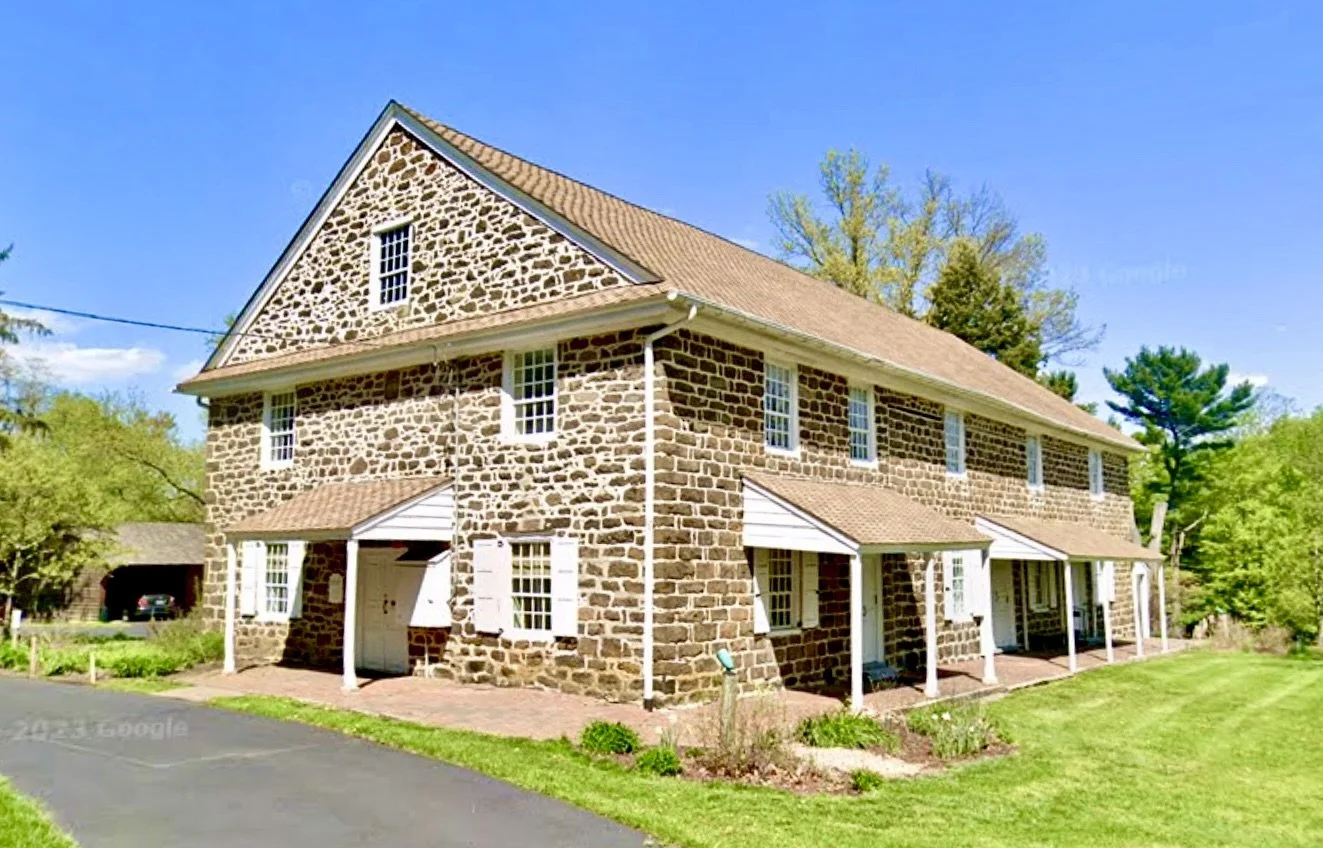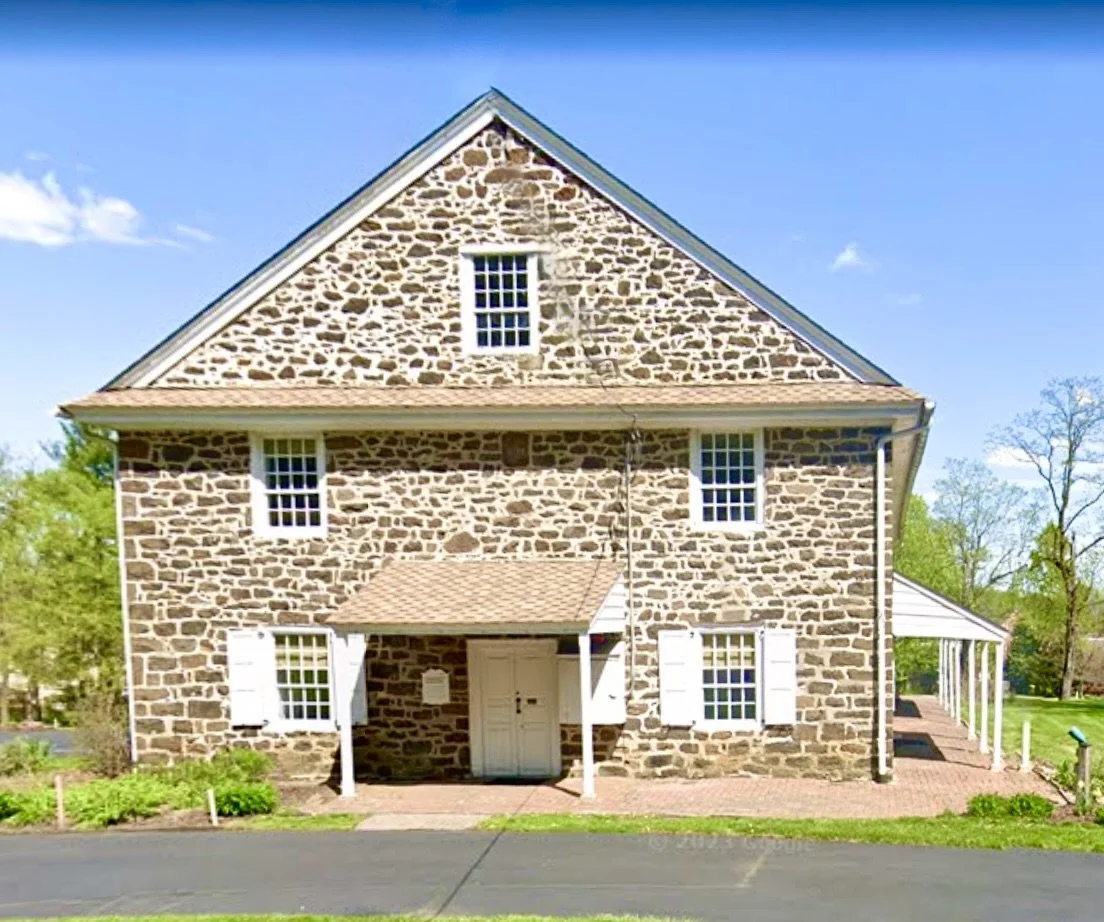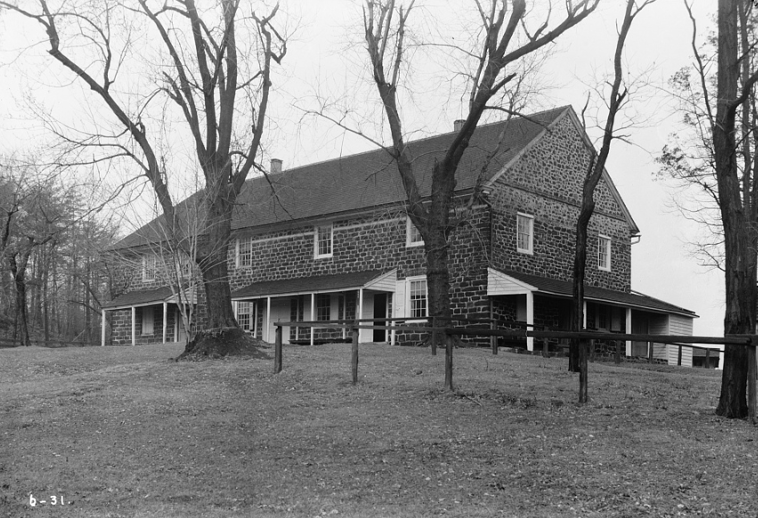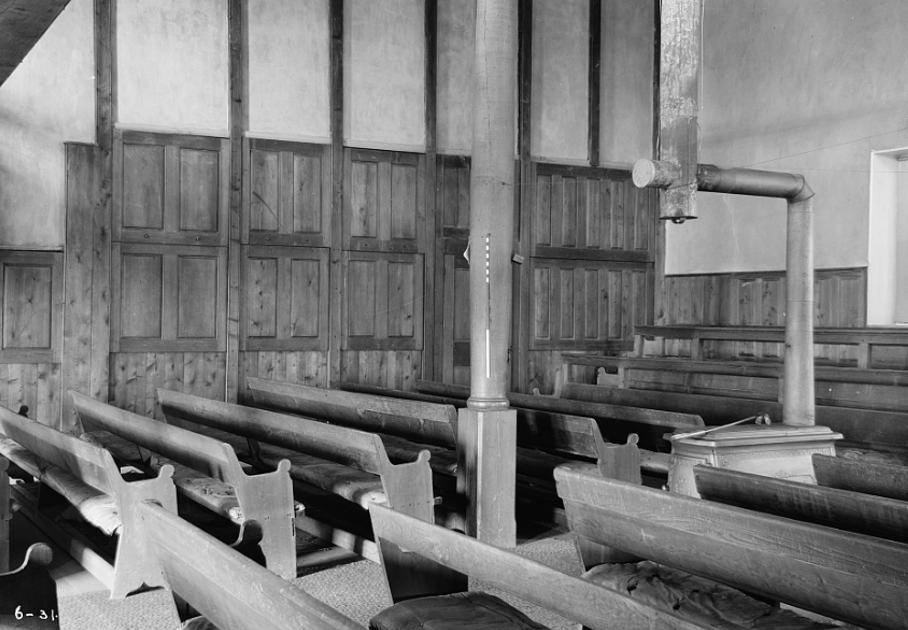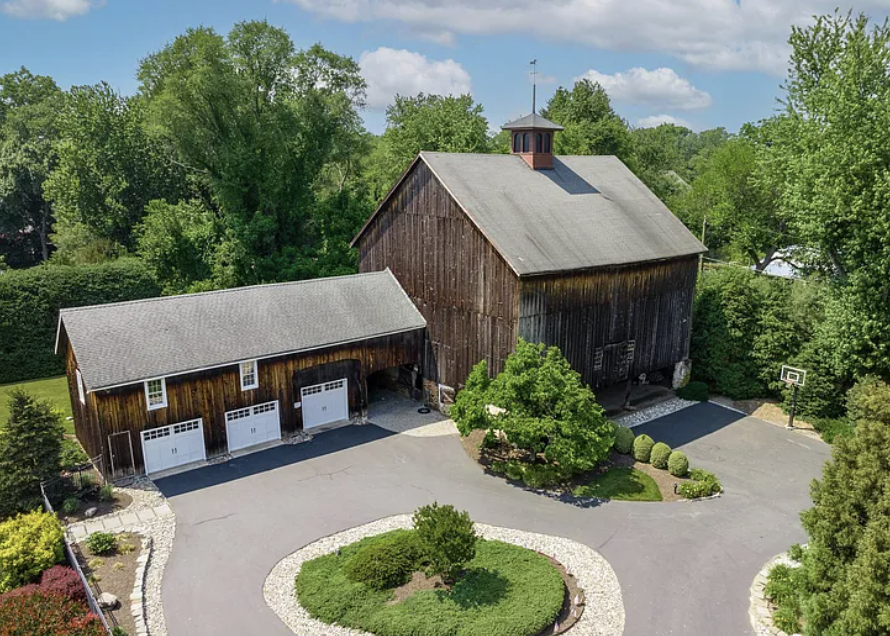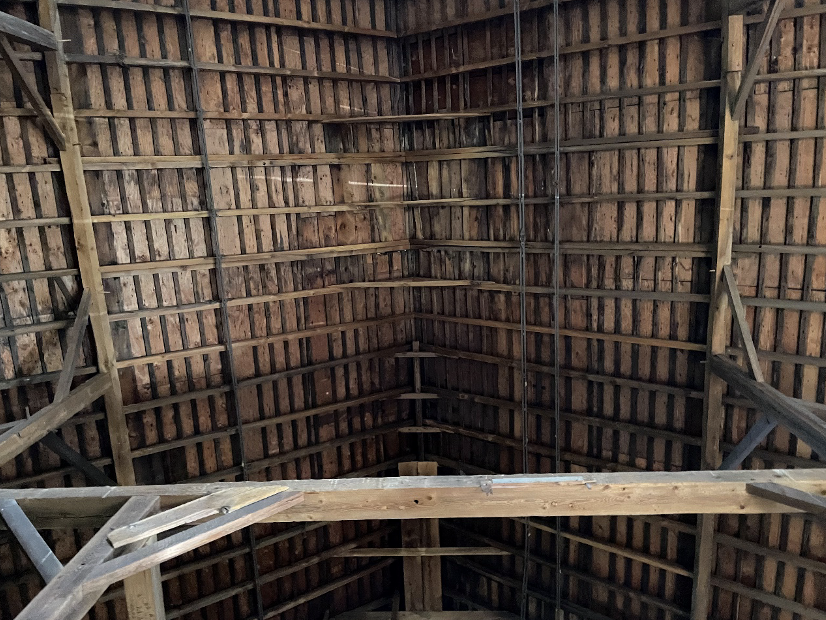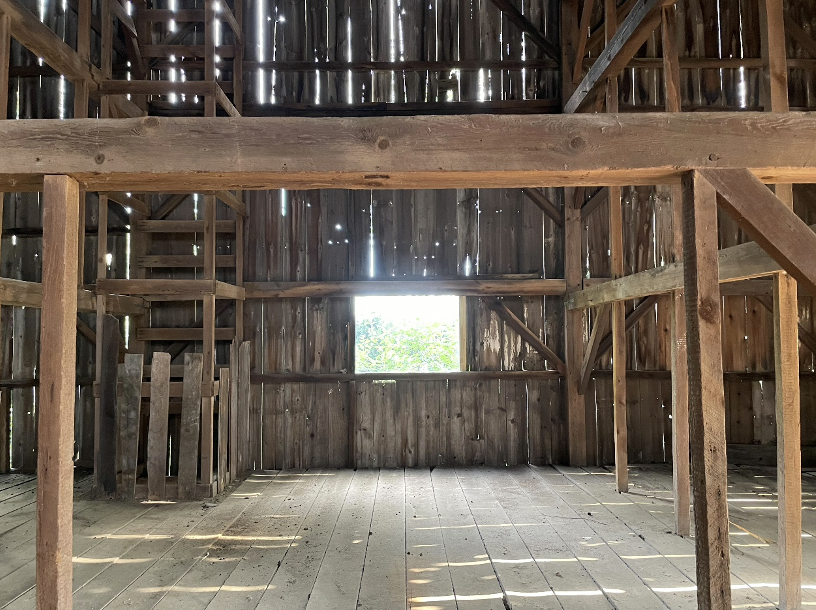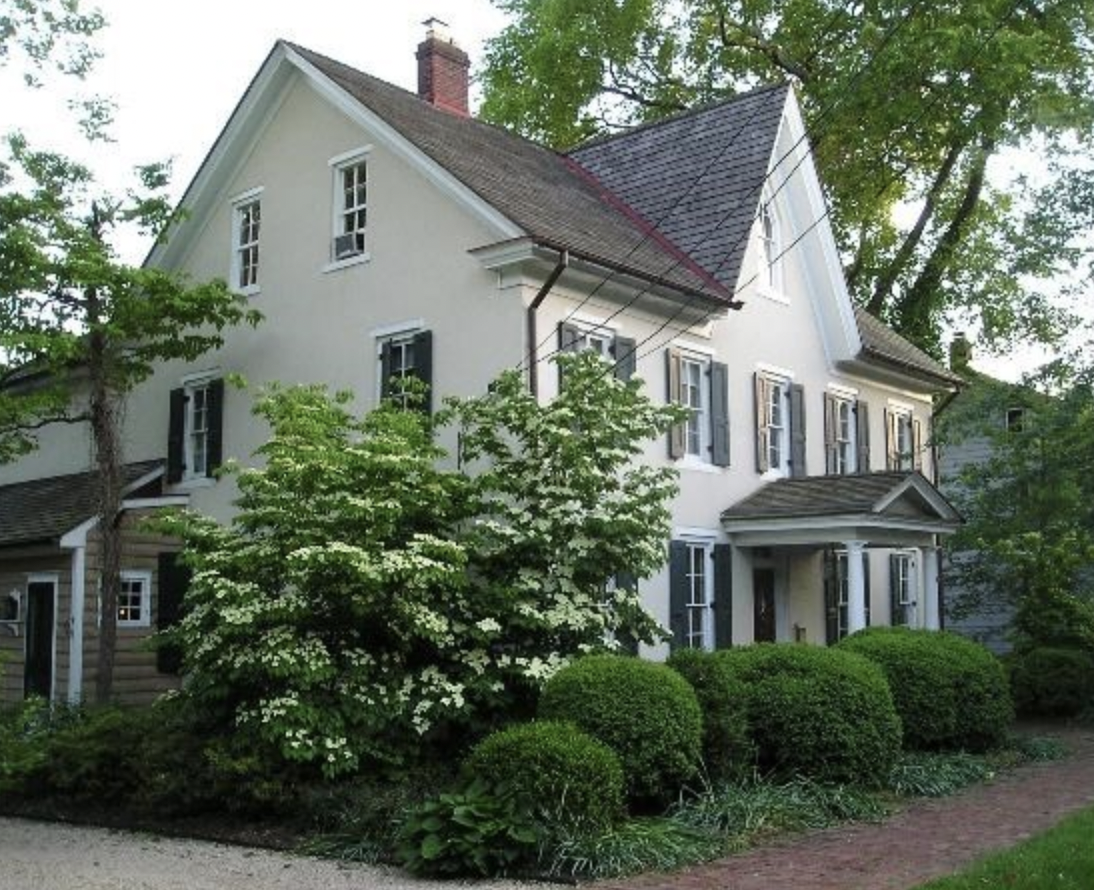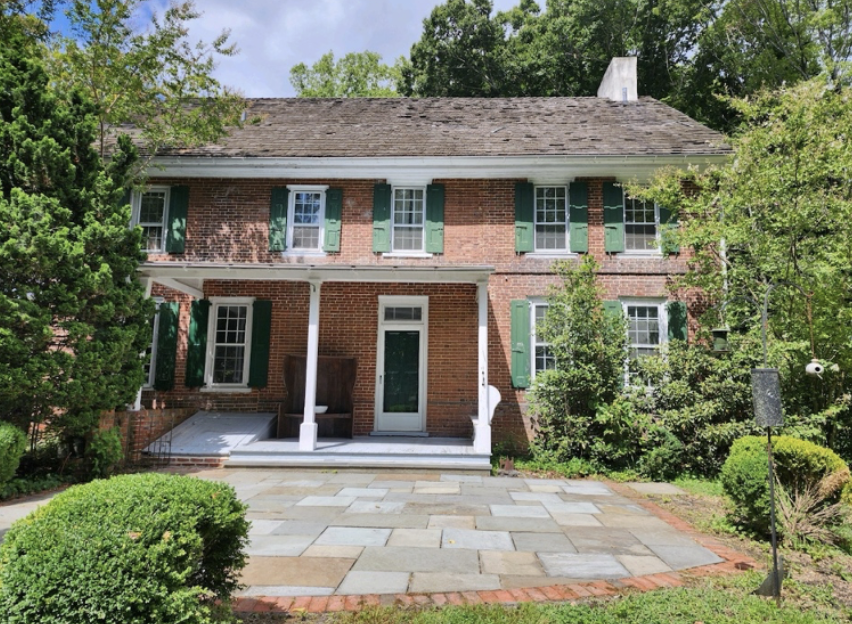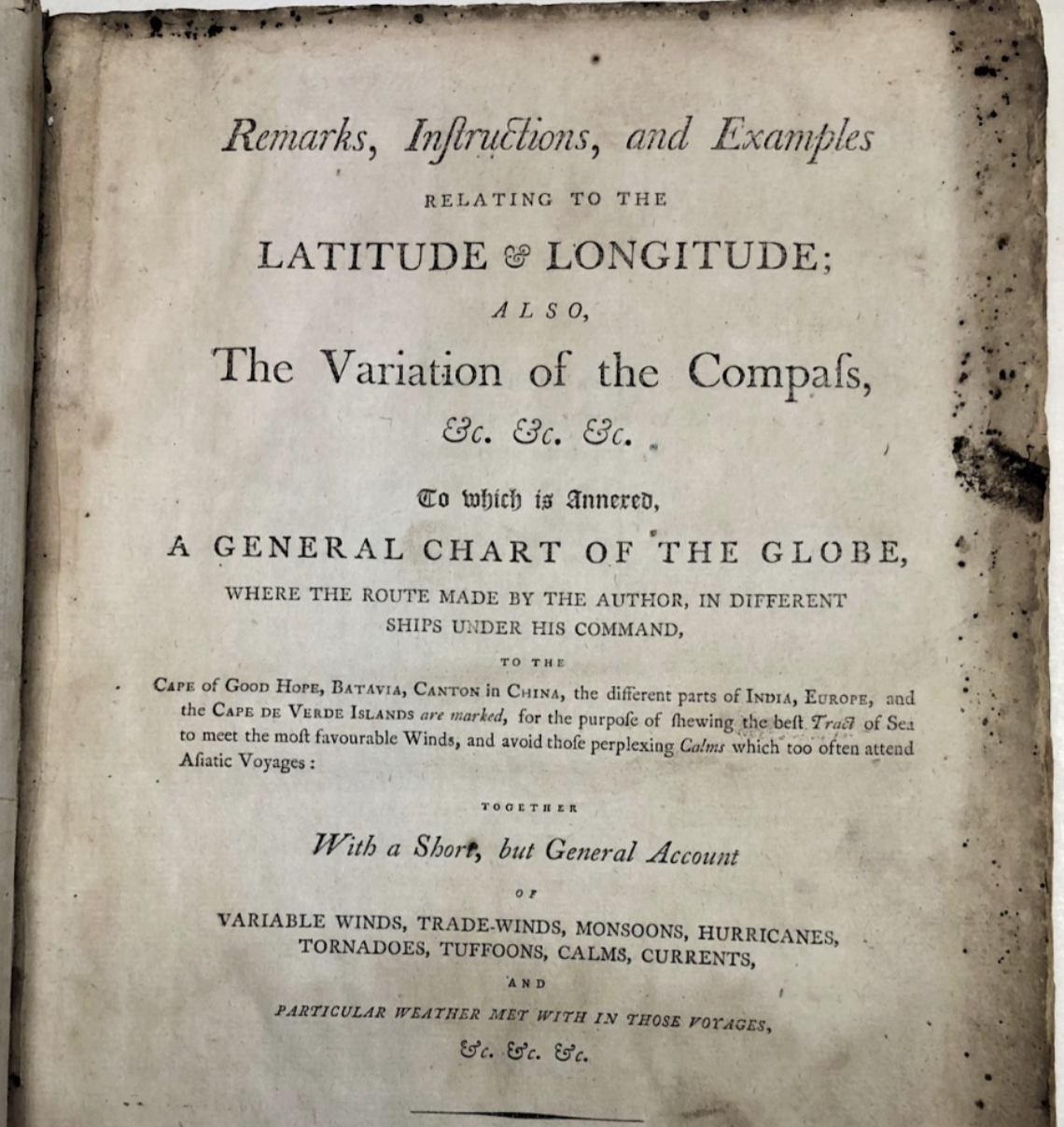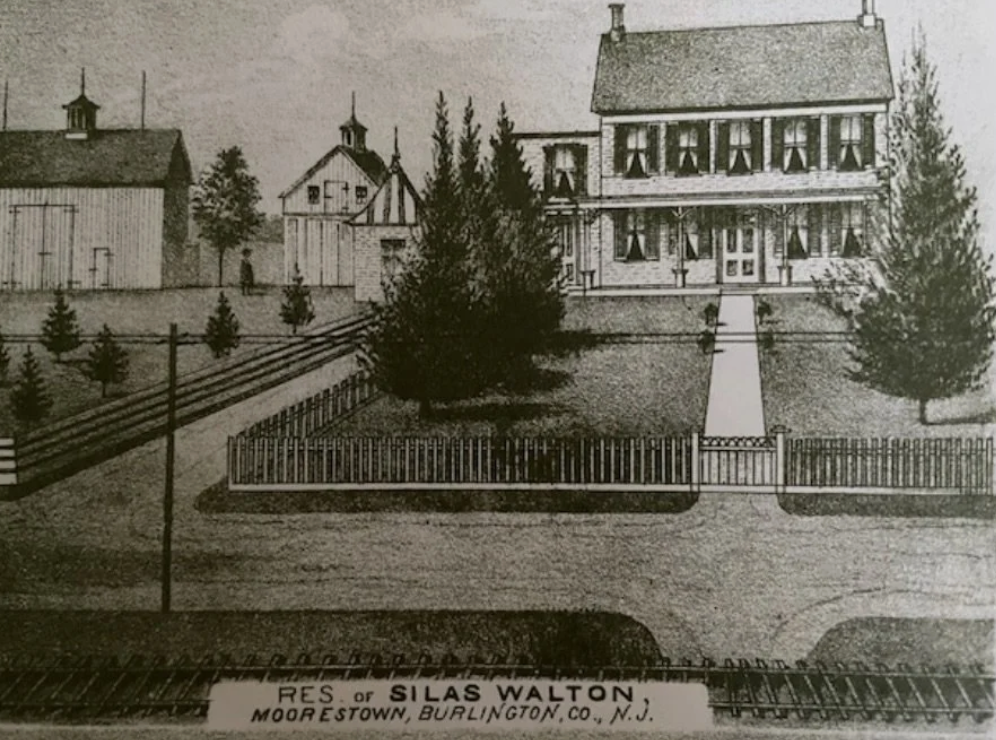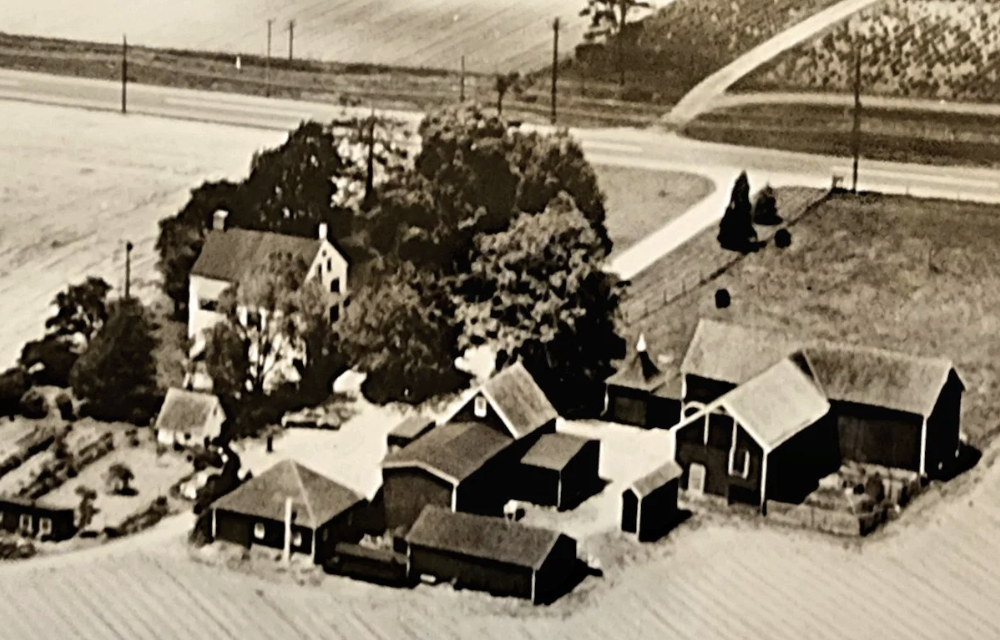
Mount Laurel Meeting House
436 Mount Laurel Road, Mount Laurel
Mount Laurel Meeting House
The Mount Laurel Friends Meeting House, also known as the Evesham Friends Meeting House, is listed on the New Jersey State and National Registers of Historic Places. It is a fine representative example of Quaker architecture. With its exceptionally well-preserved interior and ingenious movable room partitions, the Mount Laurel Meeting House is one of the most pristine and intact of the larger meeting houses in New Jersey. It is the second oldest meeting house in Burlington County and is still used for Quaker services.
Constructed of locally quarried stone, it is a large (85’ x 40'), 2-1/2-story structure built in two sections. The eastern five bays were built in 1760; and in 1798 the two-bay western section was added. On the northern facade of the meeting house are lines which indicate that a building was attached. Secondary records related that this section was built in 1698 and measured 30 x 40 feet. There is a faint outline of a foundation approximately this size that can be discerned. This unit was removed in 1828.
Meeting House, side view
Virtually all of the interior is of the period (save for electrical lighting fixtures and a 1877 stove setting in the middle of the floor). Wooden pews, stairways, wide board wainscoting, gallery, support columns, window moldings and doors are all late 18th century. Of particular importance are the ingenious vertically sliding partitions in the center of the meeting room dividing the large room into two separate rooms as necessary. While these paneled sliding partitions were typical features of the larger Quaker meeting houses, few are still completely intact in the state.
In addition to its architectural and religious importance, the meeting house and property was also the site of a military occupation during the Revolutionary War. British troops under the command of General Henry Clinton encamped on the grounds and environs of the Meeting House on June 19, 1778, during the evacuation of British and Hessian forces across New Jersey from Philadelphia to New York City.
Photos below are from the 1936 Historic American Building Survey (HABS)
Meeting House, view from front
Meeting House, side view
Meeting House, interior

Samuel Haines House
124 East Main Street, Moorestown
The house at 124 East Main Street is a contributing property in the Moorestown Historic District listed on the National and State Historic Registers.
124 East Main Street, c. 1890
The oldest portion of the house was built c. 1756. Located on the east side of the structure it included a formal parlor, a smaller back room, and two bedrooms upstairs. The entrance doorway was originally on the side. It was purposely positioned to face away from the street, to prevent dirt kicked up by passing horses from getting inside. The fireplace in the living room was said to be lined with ornamental iron manufactured in a pre-revolutionary South Jersey foundry. In the 1850s, the right side of the structure was expanded. Two stairways access the upstairs.
Living room fireplace, 2020
The house was named after a well-known resident who lived there from about 1910-1935, Dr. Samuel S. Haines, who was one of the first dentists in Moorestown.
Restoration in process
Photo taken during the restoration process.
124 East Main Street, 2020

Smith-Cadbury Mansion
It all begins with an idea. Maybe you want to launch a business. Maybe you want to turn a hobby into something more. Or maybe you have a creative project to share with the world. Whatever it is, the way you tell your story online can make all the difference.
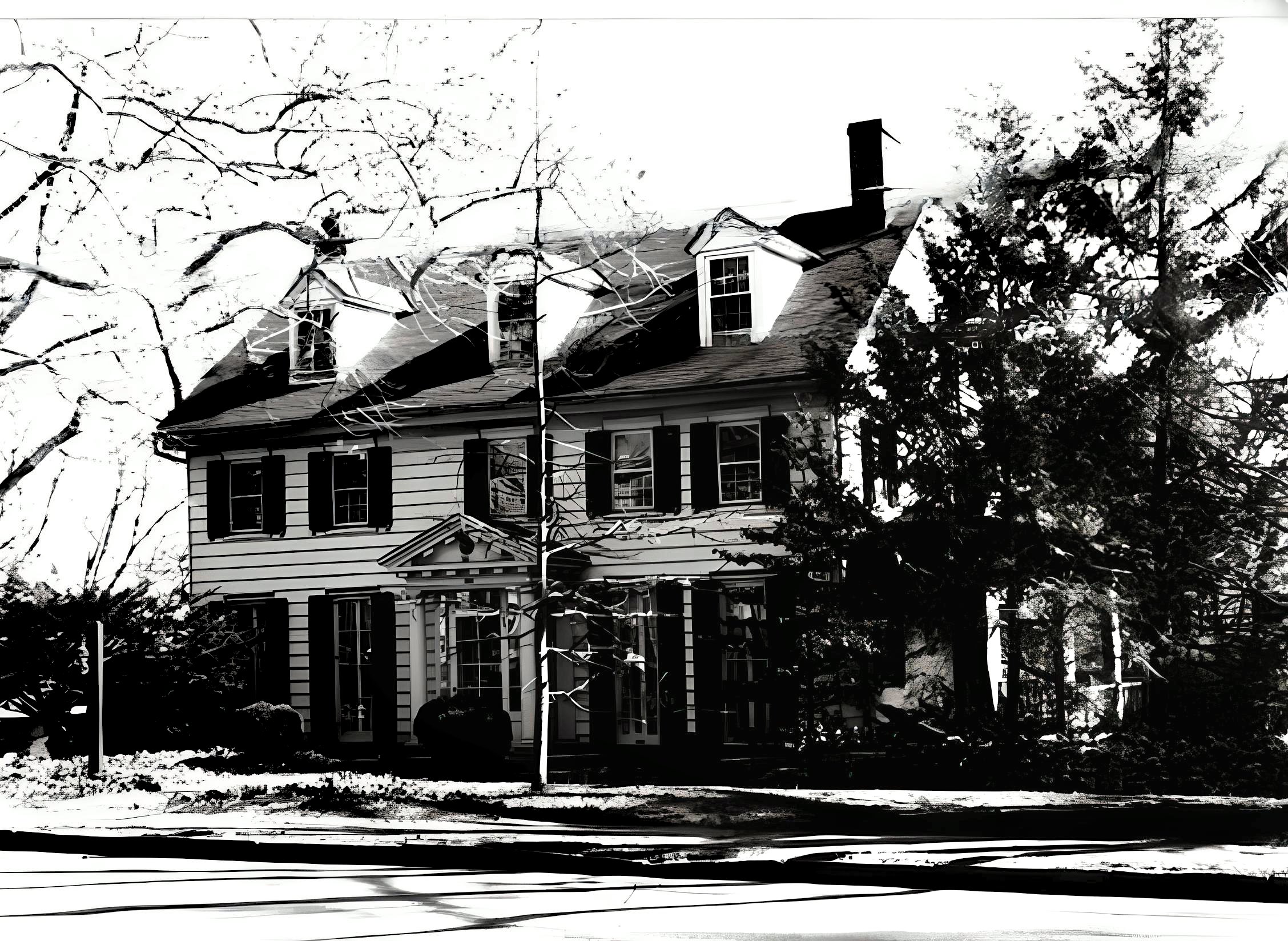
Hugh Hollinshead House
Hugh Hollinshead, a clock and watchmaker, built this house c. 1770. It is a 2-1/2 story, 5-register Georgian house, which features a front portico enclosure, porches on the right side and the rear, as well as floor-to-ceiling French doors on the front, side and rear of the house. A detached accessory building in the backyard is a carriage house with a pyramid hip roof.
The house was built using a timber framing construction style and is approximately 1500 sq. ft. with a 4-room layout. The original first-floor consisted of a front living room, dining room and kitchen. The original second-floor consisted of two bedrooms and a hallway. The original third floor configuration is unknown. Trees from the 18th century, an American Beech and a European Beech, can be found growing on the property today.
The flooring consists of random width, Old Growth Heart Pine boards in 12-15-18” widths, 10-14’ lengths, and 6/4 thickness with hand-forged nails.
Front door detail
Lightning strike scorch marks on a former outer wall. Hidden since the mid-1800s.
Hugh Hollinshead lived and had a shop here. He was a prosperous landowner of a 300 acre property as shown in the 1774 tax ratables for Burlington County. Hugh was cousin to another Moorestown clockmaker, Morgan Hollinshead whose shop, now demolished, was also located on Main Street in front of where the Moorestown Friends Meeting campus is now located. Unlike his cousin’s, very few of his tall case clocks survive to this day.
Hugh Hollinshead clock
Hugh Hollinshead House, c. 1890
Continue reading for more details…
The lane to the east of the Hollinshead House was originally part of an old road which passed between Moorestown and Mt. Laurel which was laid out as a public highway in 1761. The old road was part of a Native American system of roads that passed from the Delaware river all the way to the Atlantic Ocean. In 1796, the current Mt. Laurel Road was designed to replace the old road. The old road has been called variously “the road between Moorestown and Mount Laurel,” “the old Evesham Road” and “the road to Mount Laurel Meeting”. Having ceased to be a through road, the remnant became Pettit’s Lane, for the farm down the hill, now demolished. Through practically all of the 20th century it was known as Featherbed Lane, and it is now called Collina Way.
Porch of the Hugh Hollinshead House
After the Hollinsheads, the Higbee family lived in the house. According to the Moorestown Chronicle dated June 2, 1938, Beulah Higbee gave singing lessons to David Scull Bispham, the world famous opera baritone who spent his formative years in Moorestown.
Radiators are American Radiator Company, “Rococo” model, from approximately 1897-1902 on a twin-pipe steam system
Lydia Higbee Morris returned to this house after the death of her husband Major Louis Morris with her children Louis, Jenny and John. Major Morris fought in the Civil War and after the war was stationed with his family in Minnesota. When they returned, Lydia was an active member of the W.C.T.U.
"LM" initials, possibly Louis Morris, carved on back porch chimney stack, from mid-1800s.
This was also the long-time home of the Benjamin Cadbury family. Benjamin was very active in Quaker affairs and worked in the family business, the Hajoca Corporation, which was one of the largest plumbing, heating and industrial supply companies in the USA at the time. The initials "HJC" can be found imprinted on several pipes in the house, for Benjamin Cadbury’s HAJOCA plumbing company.
Hugh Hollinshead House, present day

Hessian House
It all begins with an idea. Maybe you want to launch a business. Maybe you want to turn a hobby into something more. Or maybe you have a creative project to share with the world. Whatever it is, the way you tell your story online can make all the difference.

Abraham Heulings House
401 Bridgeboro Road, Moorestown
Though the Heulings House dates back to the early 18th century, there is little architectural evidence of this owing to major remodeling over the years. The oldest portion of the house was built c. 1720 by Abraham Heulings. This 2-story oldest portion is believed to be part of the side of the house closest to Westfield Road. The house we see today has been built around it several times over the last 300 years.
The original frame structure is now stuccoed. A central gable was installed in the front of the attic which had a straight sided, pointed arch window. It was present as late as the 1970s but has since been removed.
Abraham Heulings House pre-1970s
Barn with cupola, pre-2023
Next to the house is a large 3-bay, 5-story, bank barn of the English type, with a heavy hewn swing beam structure. It was built in the mid 1800s and is the only one of this type in the state of New Jersey. Visible on some of the beams are the stamps of C.B. Coles & Son, a large 19-century lumber enterprise in Camden, NJ owned by Moorestown’s Charles B. Coles.
The barn has a wooden water tower on the upper level that was used to store water to cool the milk. There are stalls for horses and an area for cows on the ground floor. The barn had a 2-bay, pyramid roof Italianate-Romanesque cupola which was probably added in the mid 20th century. It was recently removed by the current owner as it was putting too much stress on the roof structure. Adjacent to the barn on the south side is a carriage house which is now used for modern “carriages.”
Barn, upper level water tower
Abraham Heulings came to America from Gloucestershire, England. He purchased large parcels of land in what is now Delanco and Riverton in the late 1600s. Abraham was a signer of the 1676 West Jersey Concessions and Agreements which was an inspiration for America’s Bill of Rights. He was orginally a Quaker but when he married non-Quaker Esther English in 1686 he was disowned. In 1701 he acquired 700 acres here from Samuel Jennings.
In 1724 Abraham sold the farm to his son Jacob for 5 shillings. The size of the property was 335 acres, or roughly half of the 1701 acreage, “together with all houses, outhouses, barns,” etc. Jacob’s brother William was deeded an adjoining tract of the same size on the same date.
Abraham was the Chester Township Overseer of Highways in 1716, as was his son Abraham in 1756 and another Abraham in 1784. Abraham Sr., was also Constable in 1713 and Freeholder during the period 1717-1719. His son Jacob was also a Freeholder from 1729-30 and 1731.
Darling Conrow, Sr., purchased the farm c. 1740. When he died in 1801 the property went to his daughter Elizabeth. She sold to Joshua Lippincott in 1808. It was owned by a variety of residents including many Lippincott family members from the mid-1800s through 1904. Since then there have been over a dozen owners.
Living room in original part of the house
Room in original part of the house
Barn, second level view
(towards Bridgeboro Road)
Barn, back entrance to second level
Barn, upper level and roof
Barn, roof interior
Barn, second level side window
Barn, second level side windows

Elisha Barcklow House
It all begins with an idea. Maybe you want to launch a business. Maybe you want to turn a hobby into something more. Or maybe you have a creative project to share with the world. Whatever it is, the way you tell your story online can make all the difference.

Moorestown Friends Meeting House
118 East Main Street, Moorestown
The Moorestown Friends Meeting House is listed both individually and in the Historic District on the New Jersey State and National Registers.
Constructed of brick, with the date worked into its west gable, the current structure is a large 2½ story example of the meeting house type. The building is lit on all sides by large multi-paned windows. A two story addition was made along its south side in 1914 and a one story social hall was added to the east in 1969.
The prominent and central position of this 40 acre campus is a testament to the importance of the Quaker tradition in the establishment of Moorestown in the 17th century.
View of the Moorestown Friends Meeting House, c. 1890
The current 1802 structure is the third meeting house built here by the Society of Friends. The first was a 1700 log meeting house which was located on the north side of Main Street where the Friends Cemetery is located. The site is identified by a bronze plaque. Fire destroyed the original meeting house in 1720, and a new one was built of stone on the same site. After its removal, the lot on which this building stood was used exclusively as a burial ground.
Continue reading for more details…
Hessian troops encamped on the original grounds and environs of the Meeting House on June 20, 1778, during the evacuation of British and Hessian forces across New Jersey from Philadelphia to New York City.
View of the Meeting House, c. 1890
Moorestown Friends Meeting House, present day

Cowperthwaite House
It all begins with an idea. Maybe you want to launch a business. Maybe you want to turn a hobby into something more. Or maybe you have a creative project to share with the world. Whatever it is, the way you tell your story online can make all the difference.

Richard Edwards House
140 East Main Street, Moorestown
The house at 140 East Main Street is a contributing property in the Moorestown Historic District listed on the National and New Jersey State Historic Registers.
140 East Main Street, present day
The oldest portion of this house was built c. 1783, during the waning days of the American Revolution by Richard Edwards. He was a prominent local citizen who served in 1782 on the township committee and was also an overseer of highways.
The 1796 Burlington County Tax Ratables record shows him owning a house, 13 acres of land, 2 horses over 2 years old and 2 cattle over 3 years old. He also had a property in Lumberton, where he was a prosperous merchant and had a thriving liquor business in Philadelphia.
Moorestown nearly lost this beautiful historic home to severe neglect in the late 1990s. It has been completely and faithfully restored and updated by the current owners. The rear portion of the house is the original, oldest part of the home. It stood as a small, two-story house. The back room which has been remodeled as a kitchen retains an early wide-beaded-board wall and cupboard stair typical of colonial era houses.
Continue reading for more details…
The house was substantially enlarged and “modernized” around 1860 with a brick addition on the front with Victorian gables. The division of the two periods is evident by the change of ceiling heights, windows and woodwork as you moved from the front rooms to the rear. The present main stair was part of the 1860 remodeling and still retains the banister from that period. A 40-foot brick well was found in the cellar.
To the rear of the home, the current owners constructed a 2-story addition for contemporary family living.
Down the hill, in the backyard, is the mid-19th century Lippincott barn, which was originally located at the Lippincott Farm on Westfield Road (where Care One is located today). Each piece of its post and beam frame was meticulously numbered and disassembled, then trucked to this location and carefully rebuilt by Amish barn framers. The beams are held together with oak pegs. In the 1850’s no nails were used in the assembly of the barn frames. The 6”x6” timbers are primarily hemlock. Amazingly, after 170 years, the frame when reassembled was still perfectly square and plumb! This barn was moved to its current location about 20 years ago and with luck, will still be standing for another 150 years. The Lippincott barn is one of Moorestown’s few remaining barns and was slated for demolition until it was moved in 2002.
The original owner, Richard Edwards, had a daughter, Ann Edwards, who was a much-loved Quaker minister active in the Chester Monthly Meeting in present day Moorestown. Ann was born into a non-Quaker family and later became a convinced Friend, i.e., a convert to Quakerism. The date of her conversion is unknown, though it must have preceded her recognition as a minister in 1808. The Edwards family did not follow her into membership in the Society, with the exception of her sister Elizabeth, who became a member in 1815.
Edwards was particularly active as a minister between 1810 and 1818; during these years she visited Virginia, New York, and Baltimore Yearly Meetings as well as many smaller meetings under their jurisdiction. She was also active in Moorestown, NJ, and the surrounding area. Ann Edwards never married. She died on February 5th, 1820, while trying to cross the frozen Delaware River in a carriage or wagon in the company of Henry Warrington Jr., Nancy Stokes, and Esther Hunt Collins. The ice gave out under the vehicle, and Edwards and Collins were lost beneath the water.
The frozen Delaware River in 1856
Another resident of this home was Clayton Lippincott, who was a respected judge and the first president of the Moorestown National Bank. He wrote an important history of Chester Township in 1883 for Woodward and Hageman’s History of Burlington and Mercer Counties. This history can be found in the book Moorestown Old and New by James Purdy.

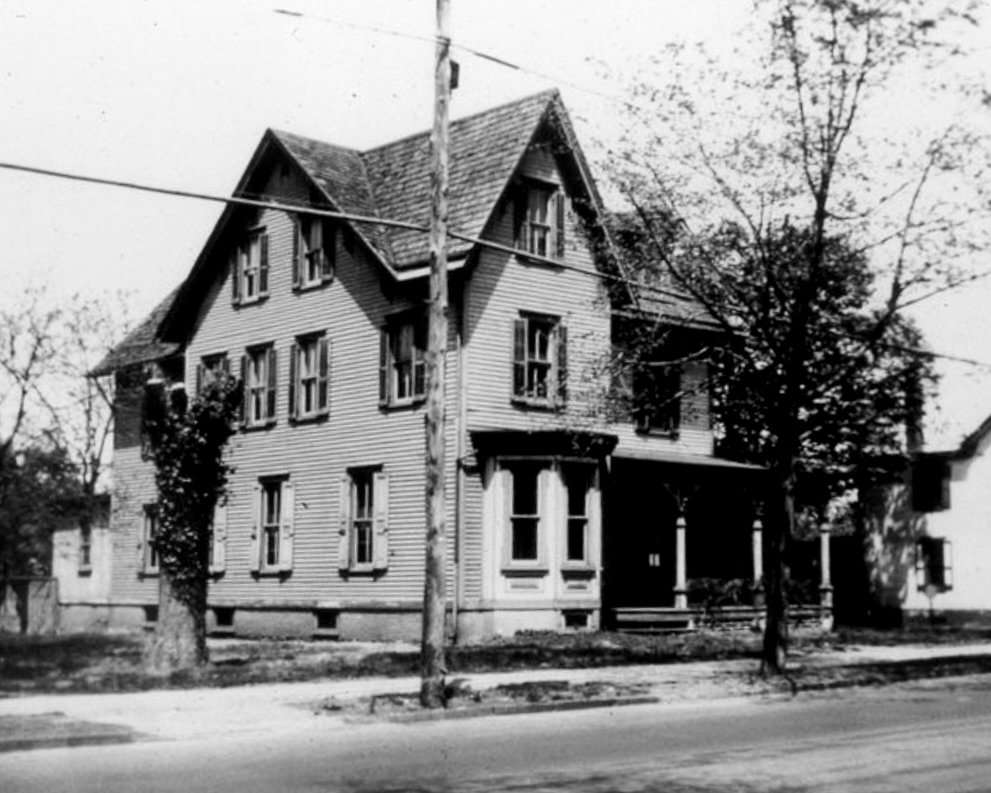
Moore's Tavern
In the early 1720s, Thomas Moore, this town’s namesake, first innkeeper and tavern owner moved to this quaint village from Salem County. At the time, the western part of Moorestown was called Rodmantown. In 1732 he bought up a large 33-acre tract of land on the north side of Main Street from just west of the Friends’ cemetery to Locust Street and bounded by what is now Second Street on the north for the sum of forty-nine pounds. As the town’s first major real estate agent, he sold most of the lots, but he set up his home and inn near the corner of Union and Main Streets. By 1745 he had applied to the state for a liquor license which was in use until at least 1760 when Moore died.
It was a small establishment by modern standards. According to James Purdy in Moorestown Old and New,
“…His ‘hotel’ consisted of just four rooms, all told. Two were on the ground floor, and two were upstairs under the roof. These latter were so unambitious that a man could stand in the middle of either of them and touch the peak of the roof with his finger tips; from which it may be inferred that no very massive furniture was at the disposal of Mr. Moore’s guests. The manner of getting up stairs, too, was somewhat different from going up in a modern elevator. The stairway was open at the back, like ordinary cellar stairs, and led up to a trap door in the floor of one of the upper rooms. At the foot the stairway was unattached, but at the top it was fastened to the beam by a pair of hinges. In the day-time, when people were not supposed to have any use for their bedrooms, the stairs were swung up against the ceiling and fastened there by an iron hook, so that they were quite out of the way. As bedtime approached, the hook was displaced and the stairs made available.”
Uriah Borton’s home at the corner of Main Street and Union Avenue, c. 1900.
In the 1890’s, the old tavern building had fallen into disrepair. It was torn down by surveyor Uriah Borton so that he could build a new home on the site. This house was later demolished in the 1930s for the installation of a gas station, which eventually became the home of Cornerstone Bank. Recently The Bank of Cornerstone Bank was converted to The Bank of Princeton.
Profiles of Notable Witness House Tours from 2024
French-Hollinshead House
512 Camden Avenue, Moorestown, NJ
This house is individually listed on the State and National Registers of Historic Places and is believed to incorporate the oldest house still standing in Moorestown.
It was once the centerpiece of a large 300 acre farm, lately known as “Forest Brook”. The house was constructed in three sections - the oldest part of which was built c. 1695 by Thomas French, Jr. This section is encompassed in the southwest corner of the building, according to the National Register nomination form for the house. Some original interior features survive to this day.
During the Revolutionary War years, the French property was occupied and raided by both British and Continental troops. Recorded damage claims reveal that Continental troops appropriated wood rails, hay, and grain in February 1777. In June 1778, British troops, retreating from Philadelphia, made off with 72 pounds, 18 shillings worth of goods.
Claim by Edward French for damages incurred from British raid in June 1778
Thomas French, Jr. was locally prominent in Moorestown in the early 18th century. He served in several church and township offices and was elected as a county freeholder. He was the first tax collector of the township, being appointed in 1693, and again, by the Governor, in 1701. He held the same office in 1723. In 1699, he was overseer of highways. In 1705, he was chosen to be constable, in 1707 - overseer of the poor, and served as freeholder 1713-14, 1720, and 1725-1728.
1819 signature of Edward’s youngest son, Charles H. French, on east facing window of the house
During the Revolutionary War period, the farm belonged to Thomas’ grandson, Edward “Neddy” French. Edward was also very involved in town and county government, serving as overseer of highways in 1773, chosen freeholder in 1784, and from 1788 through 1793. He was a member of the township committee in 1786 and from 1788 to 1794. He was also a longtime justice of the peace; and between 1795 (when the marriage license law was passed) and 1801, he married sixty-four couples.
The property remained in the French family until 1837. For a time in the 19th Century, a girl’s school was conducted here. The farm was acquired by Elwood Hollinshead and became known as Forest Brook in 1858. The Hollinshead family started subdividing their substantial acreage for development in 1914, while the home remained in the family until 1965.
Elwood Hollinshead
French-Hollinshead House, south elevation today
Commodore Truxtun/ Bispham/Walton House
Wednesday, September 25, 2024
10:00 AM - 6:00 PM
730 Marne Highway, Moorestown
The oldest portion of this historic farm house was built c. 1770 by Joshua Bispham. The residents of the house would have been witness to Hessian troops on June 20, 1778, marching up the Old Salem Road towards Mt. Holly to meet up with the rest of the British Army. Between the years 1812 and 1816, the house was owned by Commodore Thomas Truxtun, one of the US Navy’s most important early heroes.
During his retirement, the Truxtun family moved to Chester Township from Cranbury, NJ, in 1812. He moved to this 40-acre plantation he called Woodlawn, on what is now Marne Highway. His wife did not enjoy living in Cranbury, and the previous owner of this house, Dr. George Davis, wanted to move closer to family in Brunswick so they simply traded properties. The Truxtun family lived here until 1816, when he moved to Philadelphia. Tax records from 1812 show that Truxtun owned 40 acres of land, 3 horses, and 3 head of cattle. He described the property, which he intended to continue farming as previous owners had, as “handsome, healthy, and in a good neighbourhood.”
As a privateer commander during the American Revolution, he captured ten enemy ships. After the war he continued to sail in service of the nation he fought to create. He was one of six commanders appointed by George Washington to the new US Navy. In 1785 he was responsible for the safe return of Benjamin Franklin to the USA from his tour as Ambassador to France.
US Mint bronze medal, from 1800
In 1786 his ship, the Canton, was one of the first American vessels to open direct trade between China and the United States. In 1794, he published an important book on navigation, Remarks, Instructions, and Examples Relating to the Latitude and Longitude, and was one of the first to map the Gulf Stream.
Commodore Truxtun’s 1794 navigational book
He also designed the original Navy signal manual and wrote the predecessor to the Navy Regulations in use today. As commander of the USS Constellation in 1799 he defeated the French ship L’Insurgente in the Caribbean as part of the “Quasi War” with France. In 1800, he forced the surrender of another French warship, La Vengeance. Six naval ships have been named for him in recent decades, including the current USS Truxtun (DDG-103), a destroyer. He had a reputation for bravery and tenacity as a disciplined but fair commander and a superior seaman and leader.
Commodore Truxtun’s ship, the Independence, 1777, capturing a West Indiaman ship
Silas Walton was another notable owner of the plantation in the later 19th century. In addition to farming his sizable acreage, he also invented a cultivator/tiller and developed a new variety of strawberry. The house remained in the Walton family until 1983.
Drawing of the house from the 1876
J.D. Scott Atlas of Burlington County
20th century aerial view of the homestead
One of many outbuildings
Stairs and railing from 2nd to 3rd floor
2nd floor fireplace with King of Prussia marble
Outbuilding used as garage
Finial detail on garage roof
Dollhouse replica of 730 Marne Highway,
created for Walton children in the 20th century
730 Marne Highway, present day
Richard Flemming House
Wednesday, September 25, 2024
10:00 AM - 6:00 PM
243 West Main Street, Moorestown
The house at 243 West Main Street is a contributing property in the Moorestown Historic District listed on the National and State Historic Registers. It was built by Richard Flemming, c. 1775. Richard Flemming appears as a house holder on the list of Chester Township tax ratables in 1774, owing 8 shillings and 6 pence.
Flemming House, present day
Flemming moved away around 1777, according to an article in the Pennsylvania Packet:
“— The Pennsylvania Packet , September 2d, 1777…
To be SOLD by PUBLIC VENUE, on Thursday, the 18th of September instant, on the premises, a Commodious dwelling-house, and near 5 acres of ground, in Moore’s-town, Burlington County, New Jersey, within 10 miles of Philadelphia ; there are a good bearing orchard, a pump of extraordinary good water, a good hay-house and stable-room for 3 or 4 horses; the house has two good cellars under it, a lean to and a kitchen; there are two rooms on a floor both below and above stairs, and a good shop adjoining that would suit almost any tradesman. It will be sold for cash, and an indisputable title will be given to the purchaser by Richard Flemming.”
In 1801, the home was sold by Thomas Bispham, tanner, to William McElroy, turner and Windsor chair-maker. McElroy was and is a noted New Jersey chair-maker. Many of his well-constructed chairs survive to this day and are sought after by collectors of early American furniture. A stamped McElroy chair is on display at the Smith-Cadbury Mansion.
19th century McElroy chair
Historical marker
Ephraim Haines House
Wednesday, September 25, 2024
10:00 AM - 6:00 PM
201 East Main Street, Moorestown
The house at 201 East Main Street is a contributing property in the Moorestown Historic District listed on the National and New Jersey State Historic Registers.
The oldest portion of this Late Federal, stuccoed brick house was built c. 1760 by Ephraim Haines.
201 East Main Street
On June 20, 1778, British and Hessian troops encamped on his land. In his claim for damages, the items plundered or destroyed included 2750 cedar rails, 1550 oak rails, 55 oak posts, 102 apple trees, 22 sheep, 1 horse 15 years old, 1 horse 5 years old, 2 sows with pig, 11 hogs, 20 acres of grass for mowing, 3 acres of Indian corn, 5 acres of oats and flax, 3 ploughs, 35 acres of wheat and rye and 7000 feet of good pine boards. Totalling a financial loss by his reckoning of 240 pounds, 6 shillings.
Inventory of damages, claimed by Ephraim Haines, June 1778
Haines was a prominent and prosperous local citizen, owning a large portion of the land east of Chester Ave. He was an overseer of highways in 1764. The 1774 tax records for Burlington County show that he owned 278 acres, with 16 cattle and horses. He sold some of that land on the south side of Main Street for a new Friends Meeting House and school in 1781. Ephraim’s son Samuel W. Haines inherited the house and made additions and renovations to the house in the mid 1820s. Samuel was a tax collector in 1817-1818 and Sheriff of Burlington County from 1813-1816 and 1819-1822.
Foyer at 201 East Main Street
201 East Main, present day
Joshua Bispham House
Wednesday, September 25, 2024
10:00 AM - 6:00 PM
141 East Main StreetMoorestown, NJ, 08057 United States (map)
141 East Main Street, Moorestown
The house at 141 East Main Street is a contributing property in the Moorestown Historic District, and it is listed on the National and New Jersey State Registers.
141 East Main Street, on right, 1890
Built in the 18th century by Joshua Bispham, this house, like the one next door, was a witness and is said to have been a reluctant host to Hessian soldiers in June of 1778 when the British were evacuating from Philadelphia.
“The Capture of the Hessians at Trenton” by John Trumbull
Sometimes referred to as “the tannery,” oral tradition has it that the building was constructed as a tannery downstairs with quarters upstairs. The walls of the house consisted of two layers of bricks with straw and mud between them for insulation and plaster over the bricks. The house has been added onto and remodeled many times over its long life.
Continue reading for more details…
When Bispham and his first wife were coming to America from England, their daughter was born on the ship during the five month journey. The ship’s captain named the child Atlantica and presented her with silk for a dress. Bispham was Town Clerk and one of the assessors of the township during the years 1744-47, a NJ Assemblyman in 1749 and a Chosen Freeholder in 1753.
Joshua Bispham House, 1998
According to George DeCou, talking about the Hessian House next door in Moorestown and Her Neighbors, he wrote, “Old residents recall when these two buildings were connected by a one story building but I do not know when this addition was added. Some old records refer to the two properties as the barracks which was probably because the buildings were occupied by the British troops in 1778.”
On the 1876 J.D. Scott Map of Moorestown, 139 and 141 appear to be connected
Under the ownership of Asa Schooley, a harness and saddle shop occupied the space between the two houses.

